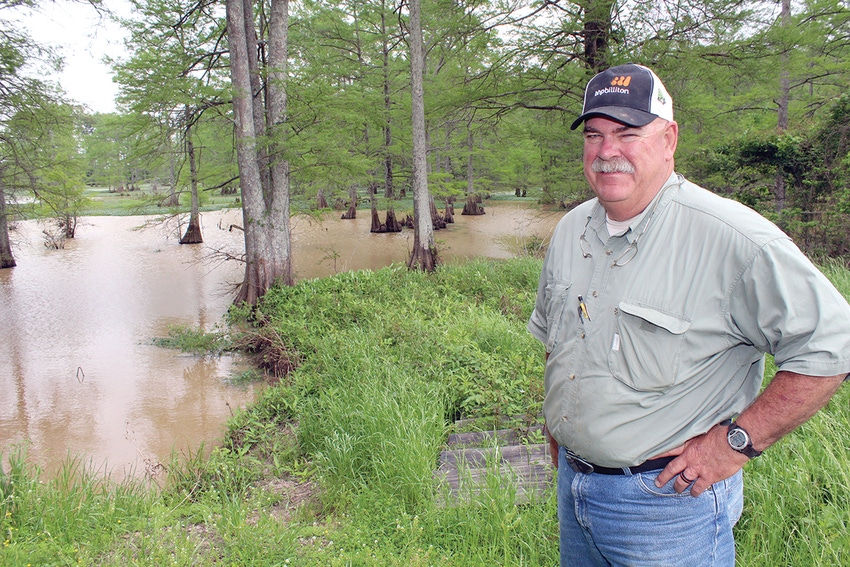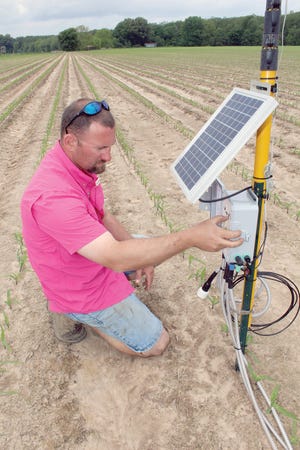
Nestled next to County Road 397, northwest of Tillar, Ark., a multi-generational row crop operation continues the family farming tradition started in 1941.
“My grandfather, who worked as a mule master for R.A. Pickins, bought the initial 60 acres of this farm after he moved out of an area called The Gourd,” says Frank Appleberry, a third generation farmer and second generation family member to graduate from the University of Arkansas.
Seventy-five year-old A&A Farms was built on cotton, but after several harvest seasons replete with hurricane-remnant winds and rains, the increased efficiencies and lower overall costs of producing grains pushed cotton out.
“Cotton will always have a place in this farm’s history, but after putting pen to paper, we made the switch to corn and soybeans.
“Since then, we’ve improved our harvesting speeds and oriented fertilizer zone maps on our John Deere 2630 monitors. We also use the 2630 monitors to map varieties so we can conduct yield analyses at the end of the season.
“We use precision planting 20/20 monitors to handle our planting prescription composite maps,” says Jacob Appleberry, who is the fourth generation of Appleberry farmers, and the third generation to graduate from the University of Arkansas. After receiving his degree on a Saturday, he was back on the farm laying irrigation pipe the following Monday.
The Appleberrys use four data management systems to verify consistency and to provide backup if problems occur. They will soon start using MyJohnDeere, a data management system, that will allow data from their equipment and/or fields to be “cloud-based” and quickly accessed or shared via the internet.
Location, Location, Location
“All but 170 acres of our land is contiguous. The farthest acre from our shop is 2.5 miles. Not only does this help with fuel costs, it reduces time we put on equipment,” says Jacob Appleberry.
If equipment breaks down or they decide to make an application, the close proximity to any field allows for a more timely response than if the field were outside of Drew County.

What Jacob Appleberry jokingly calls R2D2 is actually an AgSmarts solar-powered environmental monitoring station with tensiometer moisture probes at three depth increments. It monitors wind speed and direction, and has the capability to relay ambient and soil temperature information via the internet. (Photo: Brad Robb)
A natural brake is another unique environmental attribute from which the Appleberrys have been drawing benefits since the farm was established.
“The brake is actually a tailwater recovery point made by the good Lord. It catches water from Bayou Bartholomew and from other sources that we pump out for irrigation. Some of that water finds its way back into the brake, and we pick it up again to irrigate other acres. Some of that water then drains into a watershed ditch which carries it to other farmers further down from us,” says Appleberry.
Appleberry’s grandfather used to laugh and say, “We wear that water out, and then send it on down the line for someone else to wear out some more!”
The father and son team, along with a few neighbors, duck hunt the brake in the winter and a few frog hunt it in the spring — despite the gators that reside there.
“The brake may seem sort of minimal to some, but the water is better for our crops than ground water. It may seem like an eyesore, but it’s been a long-term, natural environmental benefit to our farm,” says the senior Appleberry.
How They Do It
When Frank and Jacob first made the switch to soybeans, they were using both pre- and post-plant herbicides, mostly for seedhead suppression in red rice before BASF came out with Clearfield Rice. Over the last 10 years however, Dayflower, a few grasses and sporadic pigweeds have been their most troublesome herbicide targets.
“We also used a lot of steel decades ago, but today Canopy and FirstRate do well for us. We even started tank-mixing Intensity with Liberty, and it’s been very effective, too,” says Appleberry.
They rely on 2-4-D for a good burndown, use a pre-emerge herbicide and if their scout sees any emerging weeds, (especially pigweed) they turn to Atrizine, Dual or Liberty.
The Appleberrys plant some of their soybeans in a twin-row configuration on 38-inch beds. This allows the plants more room to grow and the lateral branches to widen, shading out the middle of the rows to help preserve soil moisture and suppress weed growth. It also allows them to cover more planting acres quickly in a narrow weather window.
“We’re basically spreading the same amount of seed per-foot over a larger area. In addition to the wider branch growth, we’ve gotten a nice bump in yields. We’re always moving water, and we can more it more efficiently in these bigger beds,” says Jacob Appleberry.
They plant NK S48-D9 on single rows because of its expansive branch growth, which compensates for why they twin row on other soils. On their heavy soils they go with Asgrow 4632 (which has won several “Grow for the Green” contests) or HBK 4950. Frank and Jacob have seen great yields, especially after corn the previous year — which also helps slow down the proliferation of pigweed.
'Wholistic Approach'
Ford Baldwin, retired University of Arkansas Cooperative Extension Service weed scientist and a close friend, has worked with Frank and Jacob to develop a “wholistic approach" to farming that today includes the LibertyLink system which Baldwin convinced them to try when it became commercially available.
“We used to get herbicides introduced frequently, but those days are gone. Frank has been open to change, which includes more frequent scouting efforts for diseases, pests and weeds. He only sprays when and where it’s needed, alternating (and more importantly preserving) what chemistries we have left,” says Baldwin.
The father and son team cover a lot of ground with their big ground sprayer which gives them more direct placement while limiting off-target issues.
“We run low-drift, air-induction nozzles with around 24 pounds of pressure,” says Appleberry.
Frank and Jacob both like to experiment. If they find a product or process that makes them better long-term, they are all in. Neither of them would do anything else but farm. They like to say they have “skin” in what they do.
Some of Frank’s peers ridiculed him for coming back to the farm after getting his degree, but he understands more clearly what is happening in a plant or why certain chemistries work a certain way. It made him a more intellectual farmer.
“I give a lot of thanks to Charles Denver and Ford Baldwin for helping me along the way, but my father and grandfather are the reasons I’m successful today. They gave me the best farming advice anyone has ever offered me — keep pushing forward,” a resolute Frank Appleberry says, leaving his chair spinning as he walks toward the shop door.
About the Author(s)
You May Also Like




